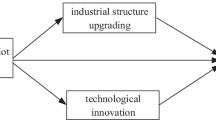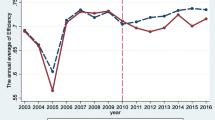Abstract
Resolving the contradiction between environmental protection and economic development is essential for sustainable development. As the world’s largest developing country, China has achieved rapid economic growth at the cost of serious environmental pollution. Taking China’s "low-carbon pilot" cities as study objects, we conduct a joint analysis of air quality and productivity to investigate the suitability of low-carbon activity to the economic development model. Using the difference-in-difference method, air quality and labor productivity are set as two explained variables, and the robustness was tested with propensity score matching. We find that the low-carbon pilot measures have improved air quality, but reduced labor productivity, which proves that China's low-carbon city pilots are a "single win" model that focuses on pollution controlling and ignoring "economic incentives." The result implies that measures should be formulated according to the life cycles of different types of local development. By testing the effects of low-carbon pilot cities policy on environment and economy, this paper provides suggestions for its implement in the whole country.
Graphic abstract




Similar content being viewed by others
Data availability
Date sets used in this study are publicly available: the number of private cars (including passenger cars and trucks) and taxis at the provincial level in China Statistical Yearbook (2007–2017), panel data of cities at the prefecture level and above from the annual China Urban Statistical Yearbook (2007–2010 and 2014–2017) and the daily report of urban air quality by the State Ministry of Environmental Protection.
Notes
The third proposal was issued in 2017, which has short time to be involved into the observation. There are 338 cities at prefecture and above levels totally in the mainland China.
The division of the eastern, central, and western region of China based on geological location and economic development level. The eastern region implemented reforms and opening-up earlier, and is economically developed. The western region is economically underdeveloped. The economic development of the central region is between the eastern and the western region.
Some sample cities in the first proposal have been involved into pilot list and other sample cities in the second proposal have not yet been included during 2010–2012. Then, the data during the period of 2010–2012 are excluded. The good days of the selected two periods are from air pollution index (API) and air quality index (AQI), respectively, that show different values.
References
Alford, W. P., & Liebman, B. L. (2000). Clean air, clean processes–The struggle over air pollution law in the People's Republic of China. Hastings LJ, 52, 703.
Beck, T., Levine, R., Levkov, A., & Big bad banks? (2010). The winners and losers from bank deregulation in the United States. The Journal of Finance, 65(5), 1637–1667
Berman, E., & Bui, L. T. M. (2001). Environmental regulation and productivity: Evidence from oil refineries. Review of Economics and Statistics, 83(3), 498–510
Bing, W., & Ning, Z. (2011). A study on the total factor productivity growth of China’s banking industry under the constraint of non-performing loans. Economic Research, 5, 32–45
Browne, M., Allen, J., & Anderson, S. (2005). Low emission zones: The likely effects on the freight transport sector. International Journal of Logistics: Research and Applications, 8(4), 269–281
Daqian, S., Hai, D., & Ping, W. (2018). Whether the construction of smart city can reduce environmental pollution. China Industrial Economy, 6, 117–135
Dias, D., Tchepel, O., & Antunes, A. P. (2016). Integrated modelling approach for the evaluation of low emission zones. Journal of Environmental Management, 177, 253–263
Dimitrov, R. S. (2016). The Paris agreement on climate change: Behind closed doors. Global Environmental Politics, 16(3), 1–11.
Ding, Y. X. (2013). Analysis and policy Suggestions on the pilot work of low-carbon development in China. Review of Economic Research, 43, 92–96
Domazlicky, B. R., & Weber, W. L. (2004). Does environmental protection lead to slower productivity growth in the chemical industry? Environmental and Resource Economics, 28, 301–324
Ellison, R. B., Greaves, S. P., & Hensher, D. A. (2013). Five years of London’s low emission zone: Effects on vehicle fleet composition and air quality. Transportation Research Part D: Transport and Environment, 23, 25–33
Färe, R., Grosskopf, S., & Pasurka, C. A., Jr. (2007). Environmental production functions and environmental directional distance functions. Energy, 32(7), 1055–1066
Holman, C., Harrison, R., & Querol, X. (2015). Review of the efficacy of low emission zones to improve urban air quality in European cities. Atmospheric Environment, 111, 161–169
Jacobson, M. Z. (2009). Review of solutions to global warming, air pollution, and energy security. Energy and Environmental Science, 2(2), 148–173
Jaffe, A. B., Peterson, S. R., & Portney, P. R. (1995). Environmental regulation and the competitiveness of US manufacturing: What does the evidence tell us? Journal of Economic Literature, 33(1), 132–163
Jia, W. (2018). The influence of urban sprawl on total factor productivity of cities—based on the analysis of panel data of prefecture-level cities. Urban Problems, 8, 48–58
Jiajun, L., Dan, S., & Qingbing, P. (2016). Evaluation of the development status of low-carbon pilot cities in China. Journal of Chongqing University of Technology: Social Science, 30(10), 32–38
Jiang, W., Boltze, M., & Groer, S. (2017). Impacts of low emission zones in Germany on air pollution levels. Transportation Research Procedia, 25, 3370–3382
Jiaqian, Li., Wentao, WanG., & Xiang, G. (2016). The contribution of the change of industrial structure to the development of low-carbon economy-take Germany as an example. China Population, Resources and Environment, S1, 26–31
Jones, A. M., Harrison, R. M., & Barratt, B. (2012). A large reduction in airborne particle number concentrations at the time of the introduction of “sulphur free” diesel and the London Low Emission Zone. Atmospheric Environment, 50, 129–138
Koop, G. (1998). Carbon dioxide emissions and economic growth: A structural approach. Journal of Applied Statistics, 25(4), 489–515
Lanoie, P., Laurentlcchetti, J., & Johnstone, N. (2011). Environmental policy, innovation and performance: New insights on the porter hypothesis. Journal of Economics and Management Strategy, 20(3), 803–842
Lei, L., Hong, L., & Xuezhong, W. (2013). Pollution characteristics and health risk assessment of volatile organic compounds in ambient air in central Guangzhou. Environmental Science, 34(12), 4558–4564
Li, W. (2014). Panel data analysis of correlation between automobile consumption and air pollution. China Population, Resources and Environment, 24(S2), 462–466
Li, Z., Guangshun, Z., & Xiayang, L. (2017). Key industrial policies and resource allocation of local governments. China Industrial Economics, 08, 64–81
Liying, S., Weiliang, Z., & Yuan, L. (2018). Study on the influence of fiscal autonomy on total factor productivity of resource-based citie. Finance and Trade Research, 3, 71–79
Neng, S. (2012). Environmental efficiency, industry heterogeneity and optimal regulatory strength: A nonlinear test of panel data of Chinese industry. China Industrial Economy, 3, 56–68
Ping, H. (2005). Effects of different education levels on total factor productivity growth: an empirical study from Chinese provinces. China Economic Quarterly, 5(1), 147–166
Pittman, R. W. (1983). Multilateral productivity comparisons with undesirable outputs. The Economic Journal, 93(372), 883–891
Porter, M. E., & van der Linde, C. (1995). Toward a new conception of the environment-competitiveness relationship. Journal of Economic Perspectives, 9, 97–118
Protocol, K. (1997). United Nations framework convention on climate change. Kyoto Protocol, Kyoto, 19, 497.
Qadir, R. M., Abbaszade, G., & Schnelle-Kreis, J. (2013). Concentrations and source contributions of particulate organic matter before and after implementation of a low emission zone in Munich, Germany. Environmental Pollution, 175, 158–167
Qijiao, S., Yufei, W., & Ye, Qi. (2015). Carbon emission status of pilot low-carbon cities in China. China Population, Resources and Environment, 01, 78–82
Rongrong, D., & Jing, Z. (2017). Did the low-carbon pilot promote the carbon emission reduction performance of the pilot cities-An empirical study based on the difference-in-difference method. Systems Engineering, 35(11), 72–77
Sands, P. (1992). The United Nations framework convention on climate change. Rev. Eur. Comp. & Int'l Envtl. L., 1, 270.
Shiyi, C. (2010). China’s green industrial revolution: An interpretation from the perspective of environmental total factor productivity (1980–2008). Economic Research, 11, 21–34
Shu, L., & Gang, C. (2013). Environmental regulation and the growth of productivity in China——Evidence from the revision of air pollution prevention and control law in 2000. Economic Research Journal, 1, 247–262.
Song Hong, S. U. N., & Yajie, C. D. (2019). Government assessment of the effects of air pollution control—an empirical study on the construction of “low-carbon cities” in China. Management World, 35(6), 95–108
Ting, J., Kunpeng, S., & Huihua, N. (2018). City level, total factor productivity and resource misallocation. Management World, 3, 38–50
Wolff, H. (2014). Keep your clunker in the suburb: Low-emission zones and adoption of green vehicles. The Economic Journal, 124(578), F481–F512
Ying, Z. (2013). Study on decoupling distribution of energy consumption and carbon dioxide emissions from China’s sustainable industrial development. Research On Development, 164(1), 104–108
Acknowledgements
We thank Mr. Zhao Xiaowei from The State Information Center (China) for the measures about the pilot cities.
Funding
This work was supported by the Fundamental Research Funds for the Central Universities (the Research Funds of Renmin University of China) (No. 18XNLY01).
Author information
Authors and Affiliations
Contributions
YY: Conceptualization, Formal Analysis, Funding acquisition, Project administration, Supervision, Validation, Writing-Original Draft and Review and Editing, Visualization; XS: Methodology, Resource, Data Collection and Calculation.
Corresponding author
Ethics declarations
Conflict of interest
The authors declare no competing interest.
Additional information
Publisher's Note
Springer Nature remains neutral with regard to jurisdictional claims in published maps and institutional affiliations.
Rights and permissions
About this article
Cite this article
Yao, Y., Shen, X. Environmental protection and economic efficiency of low-carbon pilot cities in China. Environ Dev Sustain 23, 18143–18166 (2021). https://doi.org/10.1007/s10668-021-01431-y
Received:
Accepted:
Published:
Issue Date:
DOI: https://doi.org/10.1007/s10668-021-01431-y




